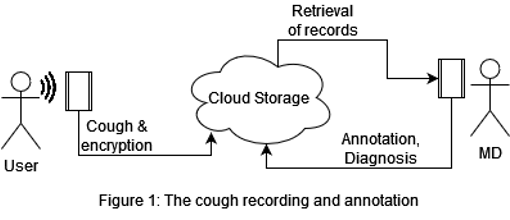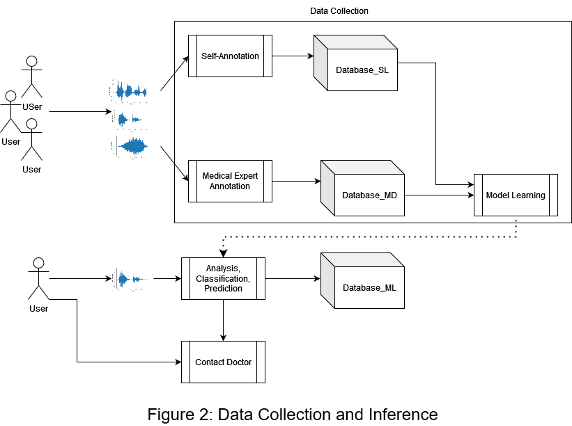
Cough is used as an early symptom for a variety of pulmonary diseases and can be used to track the progress of a respiratory disease or infection. Since the COVID-19 pandemic, cough analysis has been popularised for early symptoms indicators that were able to distinguish between COVID-19 and other types of coughs.
However, in many cases, the data is regional with high variation and high-quality differences, so the usage of cough analysis still remains in development. More generally, remote cough analysis has the advantage of allowing diagnosis at a distance and providing early evidence of a potentially more serious problem. For countries with low population density, ICT technology can provide a large set of electronic tools that improve life quality and the CoughAnalyzer focuses on such a task.
The CoughAnalyzer App
The CoughAnalyzer application is a mobile platform used to capture, store, and share cough recordings and their analysis for medical as well as experimental use. The CoughAnalyzer records sounds from contagious patients without any risk of contamination: the cough recording uses your personal mobile phone and the resulting recording is communicated to the doctor wirelessly.

The cough is recorded by the user’s phone and can be annotated by a medical examiner or by one-self (Figure 1).To annotate the coughs, the medical examiner receives the cough recording and can then perform a diagnostic.As a result of this,the patient mightr equire a direct call with the doctor ,or will have to travel to a hospital.
The annotated data are all anonymised before being stored in the database for the purpose of training assistive algorithms. One of the main tasks is the classification of the coughs as well as user’s record analysis. For the training of classification, we construct two databases. The first database contains self-annotated coughs and the second database contains medically annotated records.

The high-level schematic diagram is shown in Figure 2. The data collection builds databases of sounds with or without the doctor annotation. Classification, prediction and annotation algorithms are trained in order to determine the best generalisation between the medically and self-annotated data. Such training allows production of inference systems that can be evaluated and adapted when new records are added to the database.
Medicine and AI coming together
This project is based on the medical premise that coughs, while only indicative of possible respiratory health, could also be used to track symptomatic respiratory diseases. Long term records and records of different size conveniently available to both medical experts as well as the users would provide a powerful tool in the medical diagnostic area.
The medical side is at the center of this project from several points of view. The application is designed to provide a digital tool for the recording of patients’ coughs that are under medical examination. The application can also be used by the medical examiner to obtain information about a single cough or group of coughs. The CoughAnalyzer allows the user to track the coughs and sends them to an external specialist.
The application should serve as a medium in facilitating long distance communication with medical experts. Naturally, the integration between application and doctor specialists needs to be seamless: the usage of the system should be natural for both the medical expert and the user. While diagnostics, cough recording and storage, distance communication, and data transfer are convenient, the usability should also be attractive: smartphones provide additional sensors that can be used in more reliable and less costly diagnostics.
On the other hand, distance communication provides more work for medical examiners. Therefore, more reliable AI systems providing additional information and predictions to the medical examiner can reduce the workload of the medical experts. In particular, systems that can provide reliable analysis of the symptoms or link the data with medical records. Developing such systems requires expert knowledge. Therefore, in order to provide more advanced, reliable tools for medical purposes, one of the most important parts is interfacing and integration. The interfacing in particular must be convenient and integrated with other devices and tools so that the application is less costly and more efficient than standard tools.
Speeding up diagnoses with tech
The speeding up of diagnostics has a tremendous impact on the medical industry. Ahead of time diagnosis saves time for doctors, hospitals and customers by simply allowing the right information to be available when necessary. Faster and less costly reliable diagnosis also facilitates recovery. However, the information must be presented in an integrated manner so that the medical expert is able to smoothly and quickly assess the data, recover past records, and see time scale. Information that before might not have been easy to obtain should be available so that, even remotely, the expert can assess the patient's situation.
The CoughAnalyzer intends to develop into an international tool for audio cough capture and analysis. The overall architecture is to collect coughs from regionally different locations and provide more general evidence of a specific disease.
Medical area provides a lot of opportunities for technology. From storage, security and privacy to remote surgical operations and drugs development, the medical field already benefits greatly from automation.